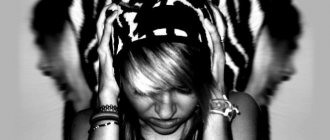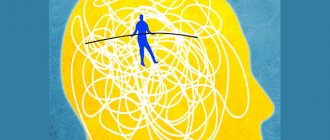Treatment of sluggish schizophrenia at the Preobrazhenie clinic is carried out on an outpatient basis, inpatient treatment using replacement methods. They make it possible to significantly better compensate for the disorder and qualitatively adapt a person in the external environment.
Our methods allow you to keep the disease under complete control and completely stabilize its condition. In society, a person behaves absolutely normally, and his internal state allows him to do any work.
Our patients continue to successfully study, work, have prosperous families and healthy children.
Stages of disease development
The first signs of the disease appear in adolescence. This is isolation, isolation, reluctance to communicate with peers, and a depressive state. However, adults rarely pay attention to them, attributing them to the peculiarities and crises of this age period, so the disease can be recognized much later.
Experts identify several stages in the development of sluggish schizophrenia.
- The first, latent period. The symptoms are subtle and mild. At this time, the patient begins to show a tendency to philosophical reflection, thinks abstractly, and withdraws into himself.
- The second, manifest period. Signs of sluggish schizophrenia become more noticeable, their active manifestation is episodic. A person withdraws more into himself, he develops phobias, obsessions and fears, panic attacks, and sleep problems. The patient stops experiencing strong emotions and loses interest in his hobbies. It is at this stage that they usually “notice” the disease, turn to a psychiatrist, make an accurate diagnosis and begin treatment.
- The third stage is stabilization. People come to him as a result of a course of medication and psychotherapy. With favorable prognosis, the patient achieves a state of stable and long-term remission, continuing to take minimal doses of drugs to prevent relapse.
Forms of the disease
Sluggish schizophrenia comes in several types.
- The depersonalized form is a violation of self-perception of the individual and the boundaries of one’s own “I”.
- Neurosis-like – characterized by a weakening of the emotional sphere, apathy, dulling of feelings.
- Asthenic – expressed in rapid fatigue, a tendency to collect various objects.
- Obsessive – manifests itself in the presence of an obsessive state. The patient can perform the same action repeatedly and create rituals that only he understands.
- Hypochondriacal – develops against the background of changes in the patient’s hormonal levels, during adolescence, during pregnancy or menopause in women. A person is confident that he has a dangerous, sometimes fatal disease, and considers his state of health to be critical.
- Psychopathic - characterized by foolishness, an arrogant attitude towards others, delusions and hallucinations.
- Affective form - a person falls into a depressive state, analyzes his actions and actions, or experiences constant fluctuations from sharp enthusiasm to complete apathy. These extremes replace each other, each time causing a deterioration in the patient’s well-being.
- Latent form - the symptoms of sluggish schizophrenia are mild and do not progress to the active stage. This type of disease has the most positive treatment prognosis.
Clinical forms (types) of schizophrenia
To understand why in modern classifications of diseases and, in particular, in ICD-10, it is customary to distinguish various forms of schizophrenia, it is necessary to have an idea of the reasons for the development of this psychopathology (endogenous psychosis) and the features of the course of the disease that have common features in a particular syndrome complex. In other words, the types of schizophrenia are determined by a set of symptoms arising from individual unfavorable physiological and genetic factors, internal conflicts, and negative life experiences.
In particular, clinical forms of schizophrenia are determined by pathological biochemical and neurophysiological processes in the body. Today, for example, there are quite a lot of studies that record the influence of inflammatory and autoimmune processes (at the level of inflammation in the bloodstream, neuroinflammation in the brain) involved in the development of endogenous psychoses. There are also studies showing changes in patients' blood chemistry, such as levels of proinflammatory cytokines, proteins, proteolytic enzymes, and autoantibodies. These studies help to evaluate subjective clinical opinion in identifying, treating and predicting remission of endogenous psychoses.
Rice. 1. Positive and negative symptoms of schizophrenia
Paranoid form of schizophrenia
One of the most common forms of schizophrenia in clinical practice is paranoid (F20.0). Its characteristic features are delusions of a paranoid nature (for example, jealousy, persecution, special purpose, high birth, bodily changes), commanding or threatening voices, visual hallucinations, perceptual deceptions - unusual bodily sensations of various kinds that have no real, somatic cause. .
The types of schizophrenia of this type can be:
- episodic (F20.01x);
- chronic (F20.00x).
The clinical picture is primarily characterized by delusions and/or hallucinations. Delusional images are usually associated with ideas of persecution or influence. Volitional, emotional, speech defects, as well as catatonic symptoms can be very mildly expressed.
Catatonic form of schizophrenia
The catatonic type of schizophrenia (F20.2) differs from others by the presence of hyperkinesis and dyskinesia. Involuntary muscle movements can range from psychomotor disturbances to stupor. Usually, during a catatonic stupor, vivid hallucinations of a fantastic nature (oneiric syndrome) are experienced, almost completely absorbing a person’s consciousness - such people practically do not make contact. In rare cases, an answer can only be obtained by addressing such a person in a whisper (Pavlov's symptom).
Negativism can be represented by various states. In some cases, patients experience waxy flexibility, automatic submission; in others - active resistance or actions opposite to direct requests, aggressive actions.
The malignant course of catatonic endogenous psychosis includes the following types of schizophrenia:
- Lucid catatonia with continuous (F20.20x)
- or paroxysmal-progressive course (F20.21x).
It is important to understand that catatonia is not only a symptom of schizophrenia. This condition can be caused by diseases of the central nervous system, metabolic disorders in the body, taking certain medications or psychoactive substances, or be a symptom of other affective disorders.
Hebephrenic (hebephrenic) form of schizophrenia
The hebephrenic form of schizophrenia (F20.1) develops in adolescence. It is not characterized by delusions and hallucinations, but they may be present in the anamnesis. According to the diagnostic criteria of ICD-10, this type of schizophrenia must satisfy one of the first signs - a pronounced flattening of affect, emotional inadequacy; as well as one of the following - unusual behavior (aimless, uncollected, “silly”), thinking disorders (broken, incoherent speech).
The hebephrenic type of schizophrenia can occur:
- occasionally (F20.11х);
- chronically (F20.10x).
In the differential diagnosis, Huntington's disease and Pick's disease must be excluded. These diseases can cause symptoms similar to the hebephrenic form of schizophrenia. Tumors of the frontal lobes of the brain, which are detected using CT and EEG, are also associated with a similar psychopathological state.
Simple form of schizophrenia
To identify a simple type of schizophrenia (F20.6), long-term observation of the patient is required, careful collection of information about him, including detailed information about childhood, growing up, the characteristics of family life and relationships between its members. In the simple form of schizophrenia, deceptions of perception and delusional disorders are not observed. They can be expressed at the level of submission to the “inner voice” or intuition, and a delusional distortion of the worldview fits harmoniously into “rational” attitudes at the personal level and into a worldview “formed on negative life experiences.”
As a rule, the type of course of simple form schizophrenia is as follows:
- continuous malignant schizophrenia (F20.6x).
People with this type of schizophrenia suffer from a deterioration in their quality of life, for example, at the level of loss of sexual desire, loss of previously occupied interests, lack of purpose in life, development of self-centeredness, loss of social connections and emotional attachment to loved ones. Negative symptoms appear and develop in the personality traits of such people - apathy, feelings and emotions become dulled or lost, nonverbal communication worsens, and the will is suppressed. All this ultimately affects life in the family and society (for example, performance in educational institutions, efficiency in the workplace). However, in the picture of the development of a simple form of schizophrenia, there are no signs of dementia or any other psychopathology.
Undifferentiated form of schizophrenia
In an undifferentiated form of schizophrenia (F20.3), symptoms of several clinical subtypes of endogenous psychosis may be observed or, conversely, the completeness of the picture of any of them may be absent. According to the type of course, this form of schizophrenia is characterized by a worsening of symptoms against the background of an increase in the duration of remission. In some cases, the diagnosis may be associated with the patient’s consequences from a head injury or from the use of psychoactive substances.
Residual (residual) form of schizophrenia
Residual schizophrenia (F20.5) is the final state in the presence of persistent endogenous psychosis. The condition corresponds to pronounced negative symptoms that form a personality defect:
- psychomotor retardation;
- lack of initiative, passivity;
- smoothed emotional background;
- speech poor in quantity and content;
- deficit of nonverbal communication;
- decreased self-care skills;
- low social activity.
This type of schizophrenia includes chronic undifferentiated schizophrenia, end states in chronic (malignant and paranoid) schizophrenia, and residual schizophrenic state. In this case, the anamnesis must include at least one psychotic episode, an episode with perceptual deceptions, and no dementia, chronic depression, or any brain pathology that can cause the above symptoms.
Neurosis-like form of schizophrenia
The neurosis-like (pseudo-neurotic) form of schizophrenia (F21.3) has neurotic symptoms - it contains phobias, obsessions, subdepression, and hypochondria. A distinctive feature from a neurotic state is the illogicality of obsessions or, in other words, delusions. Irrational thinking and emotional reactions are present in the clinical picture. Psychotic episodes may be accompanied by perceptual deceptions.
Latent form of schizophrenia
The latent form of schizophrenia (F21.1) is a prodromal (difficult to distinguish, initial) stage of endogenous psychosis. Due to the absence of psychotic symptoms, this form of schizophrenia does not have clear criteria for distinguishing it from schizoid personality disorder.
Pseudopsychopathic form of schizophrenia
The endogenous nature of pseudopsychopathic (psychopath-like) schizophrenia makes it possible to distinguish psychosis from a personality disorder. Most often, the clinical picture resembles schizoid, unstable, hysterical or epileptoid psychopathy. With the development of the disease, in contrast to the “classic” abulia and apathy, an interest in strange hobbies develops.
"Symptom-poor" form of schizophrenia
The “poor symptomatic” form of schizophrenia (F21.5) is characterized by the gradual development of autism. And although such a person adapts socially, his mental functions are reduced to the point of symbiotic coexistence with guardians or parents. In personality, mood disorders (depression, hypochondria) come to the fore, movements and facial expressions become sluggish, speech becomes poorer.
Sluggish form of schizophrenia
Sluggish schizophrenia is a difficult form to identify, is chronic in nature, and has a fluctuating course. A psychotic state is a complex of personality disorders similar to a simple form of schizophrenia, schizoid or paranoid psychopathology. In addition, one can often observe hysterical, obsessive-phobic, psychopathic states, and states of depersonalization. Personality and behavioral characteristics of such people may include:
- emotional detachment;
- eccentric behavior;
- unusual philosophical and religious beliefs;
- antisocial behavior;
- paranoid ideas;
- obsessive rumination;
- unusual perception of reality;
- somatosensory illusions;
- stereotypical thinking;
- unusual speech;
- quasi-psychotic episodes with perceptual deceptions.
Adolescent form of schizophrenia
The childhood or adolescent form of schizophrenia (F20.8xx3) has been of interest to Western and domestic psychiatrists since the end of the 19th century. In particular, a great contribution to the study of this form was made by: E. Bleuler, E. Kraepelin, F. Bromberg, L. Kanner, J. Rick, K. Kalbaum, K. Ponitz, T. Heller, N. Danillo, A. Bernstein , G. Sukhareva). To date, there are many works and studies devoted to this psychopathology, including descriptions of very rare cases of endogenous psychosis at a very early age.
The childhood form of schizophrenia manifests itself at an early age, up to 12–15 years. The picture of endogenous psychosis may include perceptual deceptions, delusions, thinking disorders, deviant behavior, inadequate or smoothed emotional reactions. However, before the age of 7 years, childhood schizophrenia is difficult to detect. Often these children are diagnosed with autism.
Resistant form of schizophrenia
Resistant form (F20.xx6) is a type of schizophrenia that is not amenable to psychopharmacotherapy. With this course of the disease, an in-depth examination and therapy with antipsychotics for up to 2 months are necessary. If such treatment does not bring results and psychotic symptoms persist, a council of doctors gathers and the issue of using the ECT method is decided.
Rice. 2. Statistics of registration of patients diagnosed with schizophrenia
Features of signs of sluggish schizophrenia
This type of mental disorder is characterized by the manifestation of two typical signs of behavior change.
- Foolishness, clowning, eccentricity, awkward and unkempt appearance. The man looks like an eccentric - he is not dressed for the weather, he moves uncertainly, his movements are clumsy and angular. Speech disturbances also occur. It becomes saturated with complex phrases, thoughts become ragged and devoid of logic. You can often observe an abrupt transition from one topic to another.
- Pseudopsychopathization . It is expressed by increased emotional excitability and the presence of overvalued ideas. The patient is not able to perceive criticism addressed to him and adequately evaluate his actions.
If you notice strange behavior in a loved one, it’s time to sound the alarm and take action. Call the “Balance” clinic by phone: +7 (499)495-45-03 . We will answer all your questions, advise you on what to do, and, if necessary, fill out an application for a doctor to be called to your home at any time of the day.
Symptoms and signs of low-grade schizophrenia
A feature of this type of mental disorder is the absence of pronounced productive and negative symptoms. The patient is not very different from normal, healthy people, and is able to lead a socially active life. Although the symptoms of the disease do not lead to personality degradation, they affect changes and deformation of behavior, thinking, areas of interest and manner of communication.
There are 7 symptoms of low-grade schizophrenia.
- Depersonalization . The patient is satisfied with his own “I”, as well as the ability to express his opinions, thoughts and feelings.
- Finding flaws in your appearance. A person is critical of himself, dissatisfied with his appearance, weight, and can lead himself to anorexia.
- Hysterical state. It is typical mainly for women. Through hysterics and tears, the patient tries to attract attention to himself.
- Solitude, isolation. A person does not want to go out, communicate with peers and immediate surroundings. The extreme manifestation of this symptom is the development of autism.
- Aggressive and affective behavior , uncontrollable outbursts of anger and irritability.
- Dulling of feelings , loss of the ability to empathize, disturbance of the emotional sphere.
- Demonstrative behavior , arrogant attitude towards others, unfounded criticism of them.
Such alarming symptoms should at least concern relatives and force them to consult a specialist. You can call our “Balance” clinic by phone: . We will make an appointment with an experienced psychiatrist. Or make an appointment yourself.
Support and Resources
If you suffer from schizophrenia, continue treatment and find and join a support group. Find out about opportunities to participate in clinical trials for new treatments. Do not suddenly stop taking your medications, do not skip doses, or change the dosage of your medications on your own. Keep in mind that while there is no magic pill for this disorder, there are thousands of people experiencing the same condition. You are not alone. And schizophrenia is treatable, especially if diagnosed at an early stage. You can still enjoy life while living with schizophrenia.
Author: Editorial staff of the Help-Point.net portal
Start working with a psychologist right now
Start a consultation
Tags: mental illness symptoms of schizophrenia treatment of schizophrenia help with schizophrenia causes of schizophrenia
Share
Comments
- Comments
Loading comments...
Previous article
Development of schizophrenia
Next article
Difficulties in diagnosis
Due to the slow progression and mild severity of symptoms, the diagnosis of “sluggish schizophrenia” is made already at the active stage of the disease. The complexity is also caused by the similarity of the symptoms of schizophrenia with a neurotic disorder. Only an experienced doctor is able to draw a clear line between these diseases and confidently make a diagnosis.
A psychiatrist at our clinic will conduct a detailed medical history, talk with the patient and his relatives, identify signs of low-grade schizophrenia, conduct laboratory tests and neuropsychological tests. Depending on the results of the study and classification of the form of mental disorder, an individual course of therapy will be selected.
Risk factors and causes of development
The issue of early detection of borderline violations remains open, since it is impossible to identify specific causes of development. The following risk factors dominate:
- heredity – the presence of a schizophrenia spectrum disease in close relatives;
- identified other mental disorders in relatives, including addiction syndrome (mainly from alcohol) and manic-depressive psychosis;
- spontaneous genome mutations in a particular individual;
- imbalance between the functioning of neurotransmitter systems in the brain;
- disturbance of human psychomotor development in early childhood and/or pathology of pregnancy in the mother;
- disharmonious socio-psychological conditions in which a child grows up, including orphanhood;
- male gender and young age are more questionable factors, since the development of pathology can occur at any period of life.
Most patients seek help before the age of 35, as symptoms interfere with daily life and reduce ability to work. About 65% of patients have higher education.
Vandysh M.V. About some clinical and social characteristics of patients with pseudoneurotic schizophrenia // Russian Psychiatric Journal. 2008. No. 2.
Treatment of the disease
Sluggish schizophrenia is the mildest type of this type of mental disorder, so its treatment and achievement of a state of remission requires smaller dosages of medications. The doctor prescribes atypical antipsychotics, nootropics, antidepressants and tranquilizers to the patient. At your request, if there are no obvious signs for hospitalization, we can conduct a course of drug therapy in a hospital setting. We have all the conditions for this - comfortable and bright VIP category rooms, without sharing, 2 and 3 beds. After discharge from the hospital, treatment can be continued on an outpatient basis.
During the rehabilitation period, it will be necessary to continue taking medications, but in minimal doses. To prevent the risk of relapse, we recommend regularly visiting a doctor at our clinic and following all his recommendations. We provide treatment on an anonymous basis. After discharge, our patient will be able to return to an active social life without fear of disclosure and condemnation from others.
You can get advice and ask any questions that concern you by calling: +7










